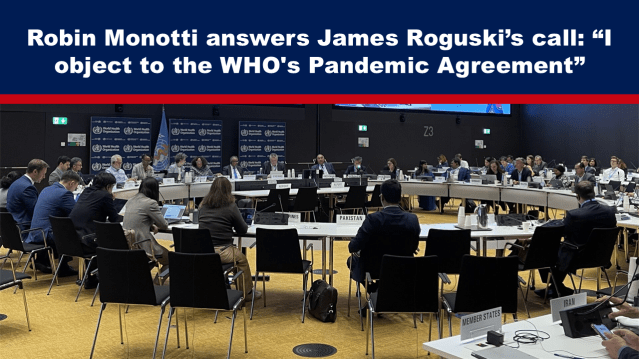Robin Monotti answers James Roguski’s call: “I object to the WHO’s Pandemic Agreement”
“I object to the WHO’s Pandemic Agreement. Medicine should only be carried out between doctor and patient,” Robin Monotti said.
It’s bad enough when governments start to dictate medicine. It’s even worse when the likes of WHO mandate “generic solutions.”
Last week, Robin Monotti, an Italian architect and film producer based in London, tweeted a video statement about his thoughts on the Pandemic Treaty that is being negotiated by a group at the World Health Organisation (“WHO”). In the comment accompanying his video, he said:
“I object to the WHO’s Pandemic Agreement. Medicine should only be carried out between doctor and patient and subject to the specificities of both. It’s bad enough when governments start to dictate generic medicine. Even worse when transnational bodies which are under the control of oligarchs, like the WHO, get to dictate what is and isn’t a medical emergency and mandate generic solutions rather than patient-specific approaches, which may even be: do nothing different and ignore the fearmongering!”
Monotti was answering a call James Roguski has been making for a couple of weeks and reiterated in a recent interview with Noor Bin Ladin. He discussed WHO’s progress with the Pandemic Treaty, what this agreement really is about, the upcoming negotiating meetings and why you must publicly voice your dissent.
“This document,” Roguski said waving the Pandemic Agreement, is a “glorified, corrupt, racketeering – I hesitate to call it a trade agreement – but it’s about business. It’s crony capitalism to funnel money through all kinds of different sources from all kinds of different donors.”
“And the people who are pushing for it,” he said, “really should be called special interest lobbyists but they refer to them as ‘relevant stakeholders’.”
He continued, “There’s like 400 organisations who are participating in these [Pandemic Agreement] negotiations but do we get to participate? Does anybody ask the people? Has anyone in government said, ‘Hey, what is it that people want?”
“So, I have been asking everyone for the last couple of weeks, and I’ll ask you and I’ll ask everyone in the audience: Please, take out your phone, take out the camera, take out your laptop or your computer – or borrow one of those things from somebody … and speak your mind and put your public statement out there, on the internet on one of the many video posting platforms that are out there,” he said.
After researching what the Pandemic agreement is about and whether you support WHO’s plans or not, Roguski is ready to also receive your video statements. He will publish an article compiling all the videos he receives. You can send your video to him either via text message on (USA) 310-619-3055 or via email at james.roguski@gmail.com.
“Publish your statement [on social media or the internet],” he said, “because at this point in time, as always, your silence is equivalent to your consent … If you’re silent and not going to speak up about it, nothing’s going to change.”
Watch HERE
In May, the World Health Assembly (“WHA”) ended without a Pandemic Agreement being adopted as hoped. However, the assembly “made concrete commitments to completing negotiations on a global pandemic agreement within a year, at the latest.”
Since then, WHO’s Intergovernmental Negotiating Body (“INB”) has met twice, once in July, the 10th time the body has convened since its inception, and again in September for the 11th time. INB was established in 2021 by WHO to draft and negotiate a convention, agreement or other international instrument on pandemic prevention, preparedness and response
Yesterday, WHO released a provisional agenda for the 12th meeting of the INB, which is scheduled to take place next month from 4 to 15 November.
The second item on the agenda is: “Negotiation of and agreement on the proposed WHO Pandemic Agreement.” Note the words “agreement on.” The intention is for the INB to agree on the final text of WHO’s proposed Pandemic Agreement so that it can be put forward for adoption at the next WHA.
The Pandemic Agreement has taken on various names since the concept of a global health dictatorship using pandemics was first publicised. It began by being described as an “international treaty for pandemic preparedness and response” when on 30 March 2021 24 world leaders and Tedros the Terrorist signed a joint letter calling for it to be established. Since then, it has also been referred to using various names including the Pandemic Accord, Pandemic Treaty and WHO Convention Agreement + (“WHO CA+”).
Related: G7 Summit to issue another statement on the Pandemic Treaty
Roguski noted in an article yesterday, “They have publicly stated that they hope to reach agreement during their next set of meetings on a streamlined version of the ‘Pandemic Agreement’, which some people have referred to as the Pandemic Agreement ‘Lite’.”
According to Roguski, they desperately want to reach an agreement in November so they can call a World Health Assembly in December before Joe Biden leaves office.
As “the negotiations are not even close to reaching a consensus, they have suggested splitting the ‘Pandemic Agreement’ into three separate legal instruments,” Roguski wrote on 7 October. The benefit to them of splitting the Pandemic Agreement into three is that the contentious issues in the proposed Pandemic Agreement presented to the WHA in May can be kicked down the road while the foundations of the ‘Pandemic Agreement’ are agreed.
As Health Policy Watch noted, “The latest draft of the World Health Organisation’s (WHO) pandemic agreement shifts key decisions to the Conference of the Parties (COP) – a body that will be set up after the World Health Assembly (WHA) has adopted the agreement.”
Related: WHO releases draft Pandemic Treaty with COP to ensure implementation and compliance
WHO’s three instruments for pandemic preparedness and response are now:
Pandemic Agreement.
Pathogen Access and Benefit Sharing (PABS) instrument, which was previously Article 12.2 of the last officially released draft of the Pandemic Agreement.
Pandemic prevention and surveillance instrument, which was previously Article 4.3 of the last officially released draft of the pandemic Agreement.
Neither of the two new instruments has yet been made publicly available. You can read the last officially released draft of the Pandemic Agreement dated 27 May 2024 HERE and the latest unofficial draft released by Health Policy Watch on 19 September 2024 HERE.
“If we allow the ‘powers that be’ to get what they want, the details of these international ‘instruments’ will be determined after the ‘Pandemic Agreement’ has been adopted,” Roguski wrote.
Further reading:
The International Monetary Fund, the World Bank Group, and the World Health Organisation step up cooperation on pandemic preparedness, Meryl Nass, 4 October 2024
The Pandemic Treaty developers do not want to tell other negotiators how they actually envision it working, Meryl Nass, 9 October 2024
Are the Pandemic Treaty negotiators being silently cut out of negotiations on pathogen access and benefits? Meryl Nass, 9 October 2024
Featured image: Governments progress on negotiations for a pandemic agreement to boost global preparedness for future emergencies, World Health Organisation, 20 September 2024




